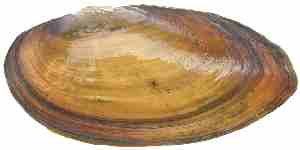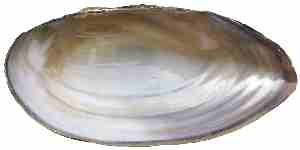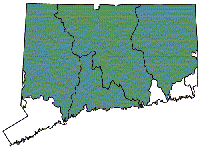Alewife Floater
Anodonta implicata
Key Features
Size: Up to seven inches.
Shape: Somewhat elongate, with a rounded ventral margin. The hinge ligament is usually straight. The valves are laterally inflated.
Periostracum: Color variable—may be yellowish, greenish, reddish, brown, or black, though most commonly yellowish-brown. Growth lines are prominent, and shell rays are often only evident in juveniles.
Lateral Teeth: Absent.
Pseudocardinal Teeth: Absent.
Nacre: Color usually white, pinkish, or a pale copper color. The ventral margin of each valve is noticeably thicker toward the anterior end [this is important for distinguishing this species from the eastern floater].
Often Confused With ... Eastern floater, creeper

External shell

Internal shell, right valve

Hinge teeth
 Habitat: The alewife floater is found in streams, rivers, ponds, and lakes that have runs of anadromous clupeids, particularly the alewife, Alosa pseudoharengus. It inhabits a variety of substrate types.
Habitat: The alewife floater is found in streams, rivers, ponds, and lakes that have runs of anadromous clupeids, particularly the alewife, Alosa pseudoharengus. It inhabits a variety of substrate types.
Range in Connecticut: The alewife floater exists in nearly all major watersheds in Connecticut but is confined to the upstream limits of its anadromous host fish.
Conservation: The alewife floater is usually abundant but has a restricted distribution because of its reliance on anadromous fish. Disruption of anadromous fish migration, due to dams, may have caused the extirpation of the alewife floater in some locales throughout Connecticut. Installation of adequate fish passage facilities may allow the re-establishment of alewife floater populations upstream of dams.
Freshwater Mussel Fact Sheets
Eastern Pearlshell
Dwarf Wedgemussel
Triangle Floater
Brook Floater
Creeper
Eastern Elliptio
Eastern Floater
Alewife Floater
Eastern Pondmussel
Tidewater Mucket
Yellow Lampmussel
Eastern Lampmussel
The Freshwater Mussels of Connecticut
Content last updated on January 29, 2014.

